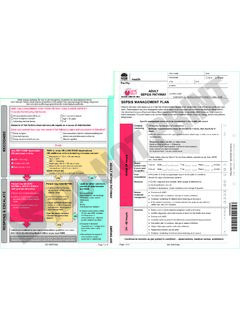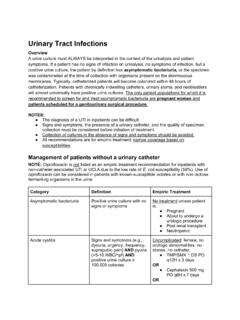Transcription of ANNEX I SUMMARY OF PRODUCT CHARACTERISTICS
1 1 ANNEX ISUMMARY OF PRODUCT OF THE MEDICINAL PRODUCTIMBRUVICA 140mg hard AND QUANTITATIVE COMPOSITIONEach hard capsule contains 140mg of the full list of excipients, see FORMHard capsule(capsule).White opaque, hard capsule of 22 mm in length, marked with ibr 140mg in black indicationsIMBRUVICA as a single agent is indicated for the treatment of adult patients with relapsed or refractory mantle cell lymphoma (MCL).IMBRUVICA as a single agent or in combination with rituximab or obinutuzumab is indicated for the treatment of adult patients with previously untreated chronic lymphocytic leukaemia (CLL) (see ).IMBRUVICA as a single agent or in combination with bendamustine and rituximab(BR)is indicated for the treatment of adult patients with CLLwho have received at least one prior as a single agent is indicated for the treatment of adult patients with Waldenstr m s macroglobulinaemia (WM) who have received at least one prior therapy, or in first line treatment for patients unsuitable for in combination with rituximab is indicated for the treatment of adult patients with and method of administrationTreatment with this medicinalproduct should be initiated and supervised by a physician experienced in the use of anticancer medicinal recommended dose for the treatment of MCL is 560mg (four capsules) once and WMThe recommended dose for the treatment of CLL and WM, either as a single agent or in combination, is 420mg (three capsules)
2 Once daily (for details of the combination regimens, see ).Treatment should continue until disease progression or no longer tolerated by the administering IMBRUVICA in combination with anti-CD20 therapy, it is recommended to administer IMBRUVICA prior to anti-CD20 therapy when given on the same adjustmentsModerate andstrongCYP3A4 inhibitors increase the exposure of ibrutinib(see sections ).The dose of ibrutinib should be reduced to 280mg once daily (two capsules) when used concomitantlywith moderate CYP3A4 dose of ibrutinib should be reduced to 140mg oncedaily (one capsule) or withheld for up to 7 days when it is used concomitantly with strong CYP3A4 should be withheld for any new onset or worsening grade 3 non-haematologicaltoxicity, grade3 or greater neutropenia with infection or fever,or grade4 haematological toxicities. Once the symptoms of the toxicity have resolved to grade1 or baseline (recovery), IMBRUVICA therapy may be reinitiated at the starting dose.
3 If the toxicity reoccurs, the once daily doseshould be reducedby one capsule(140mg). A second reduction of dose by 140mg may be considered as needed. If these toxicities persist or recur following two dose reductions, discontinue the medicinal dose modifications are described below:Toxicity occurrenceMCL dose modification after recoveryCLL/WMdose modification after recoveryFirstrestart at 560mg dailyrestart at 420mg dailySecondrestart at 420mg dailyrestart at 280mg dailyThirdrestart at 280mg dailyrestartat140mg dailyFourthdiscontinue IMBRUVICA discontinue IMBRUVICAM issed doseIf a dose is not taken at the scheduled time,it can be taken as soon as possible on the same day with a return to the normal schedule the following day. The patient should not take extra capsules to make up the missed populationsElderlyNo specific dose adjustment is required for elderly patients (aged 65years).
4 Renal impairmentNo specificclinical studies have been conducted in patients with renal impairment. patients with mild or moderate renal impairment were treated in IMBRUVICA clinical studies. No dose adjustment is needed for patients with mild or moderate renal impairment (greater than 30mL/min creatinine clearance).Hydration should be maintained and serum creatinine levelsmonitored periodically. Administer IMBRUVICAto patients with severe renal impairment (<30 mL/min creatinine clearance) only if the benefit outweighs the risk and monitor patients closelyfor signs of toxicity. There areno data in patients with severe renal impairment or patients on dialysis (see ).Hepatic impairmentIbrutinib is metabolised in the liver. In a hepatic impairment study, data showed an increase in ibrutinib exposure (see ). For patients with mild liver impairment (Child-Pugh classA), the recommended doseis 280mg daily(twocapsules).
5 For patients with moderate liver impairment (Child-Pugh classB), the recommended dose is140mgdaily(onecapsule). Monitor patientsfor signs of IMBRUVICA toxicity and follow dose modification guidance as needed. It is not recommended to administer IMBRUVICAto patients with severe hepatic impairment (Child-Pugh classC).Severe cardiac diseasePatients withseverecardiovascular diseasewere excluded fromIMBRUVICA clinical populationThe safety and efficacy of IMBRUVICA in children and adolescents aged 0 to18 years have not beenestablished. No data are of administrationIMBRUVICA should be administered orally once daily with aglass of waterapproximatelyat the same time each day. The capsules should be swallowed whole with water and should not be opened, broken, or chewed. IMBRUVICA must not be taken with grapefruit juiceor Seville oranges(see ). the active substance or to any of the excipients listed in of preparations containing sWort is contraindicated in patients treated with warnings and precautions for useBleeding-related eventsThere have been reports of bleeding events in patients treated with IMBRUVICA, both with and without thrombocytopenia.
6 These include minor bleeding events such as contusion, epistaxis, and petechiae; and major bleeding events, some fatal, including gastrointestinal bleeding, intracranial haemorrhage, and or other vitamin K antagonists should not be administered concomitantly with of either anticoagulants or medicinal products that inhibit platelet function (antiplatelet agents) concomitantly with IMBRUVICA increases the risk of major bleeding. A higher risk for major bleeding was observed with anticoagulant than with antiplatelet agents. Consider the risksand benefits of anticoagulant or antiplatelet therapy when co-administered with IMBRUVICA. Monitor for signs and symptoms of such as fish oil and vitamin E preparations should be be held at least 3 to 7days pre- and post-surgery depending upon the type of surgery and the risk of mechanism for the bleeding-related events is not fully understood.
7 patients with congenital bleeding diathesis have not been of leukostasis have been reported in patients treated with IMBRUVICA. A high number of circulating lymphocytes (>400,000/mcL) may confer increased risk. Consider temporarily withholding IMBRUVICA. patients should be closely monitored. Administer supportive care including hydration and/or cytoreductionas ruptureCases of splenic rupture have been reported following discontinuation of IMBRUVICA treatment. Disease status and spleen size should be carefully monitored ( clinical examination, ultrasound) when IMBRUVICA treatment is interrupted or ceased. patients who develop left upper abdominal or shoulder tip pain should be evaluated and a diagnosis of splenic rupture shouldbe considered. InfectionsInfections (including sepsis, neutropenic sepsis, bacterial, viral, or fungal infections) were observed in patientstreated withIMBRUVICA.
8 Some of these infections have been associated with hospitalisation 5and patients with fatal infections also should be monitored for fever, abnormal liver function tests, neutropenia and infections and appropriate anti-infective therapyshould be instituted as prophylaxis according to standard of care in patients who are at increased risk for opportunistic of invasive fungal infections, including cases of Aspergillosis, Cryptococcosis and Pneumocystis jiroveci infections have been reported following the use of ibrutinib. Reported cases of invasive fungal infections have been associated with fatal of progressive multifocal leukoencephalopathy (PML) including fatal ones have been reported following the use of ibrutinib within the context of a prior or concomitant immunosuppressive therapy. Physicians should consider PML in the differential diagnosis in patients with new or worsening neurological, cognitive or behavioral signs or symptoms.
9 If PML is suspected then appropriate diagnostic evaluations should be undertaken and treatment suspended until PML is excluded. If any doubt exists, referral to a neurologist and appropriate diagnostic measures for PML including MRI scan preferably with contrast, cerebrospinal fluid (CSF) testing for JC Viral DNAand repeat neurological assessments should be eventsCases of hepatotoxicity, hepatitis B reactivation, and cases of hepatitis E, which may be chronic, have occurred in patients treated with IMBRUVICA. Hepatic failure, including fatalevents, has occurred in patients treated with IMBRUVICA. Liver function and viral hepatitis status should be assessed before initiating treatment with IMBRUVICA. patients should be periodically monitored for changes in liver function parameters during treatment. As clinically indicated, viral load and serological testing for infectious hepatitis should be performed per local medical guidelines.
10 For patients diagnosed with hepatic events, consider consulting a liver disease expert for grade3 or 4 cytopenias (neutropenia, thrombocytopenia and anaemia) were reported in patients treated with IMBRUVICA. Monitor complete blood counts Lung Disease (ILD)Cases of ILD have been reported in patients treated with IMBRUVICA. Monitor patients for pulmonary symptoms indicative of ILD. If symptoms develop, interrupt IMBRUVICA and manage ILD appropriately. If symptoms persist, consider the risks and benefits of IMBRUVICA treatment and follow the dose modification arrhythmiaand cardiac failureAtrial fibrillation, atrial flutter, and cases of ventricular tachyarrhythmiaand cardiac failure have been reported in patients treated with IMBRUVICA. Cases of atrial fibrillation and atrial flutterhave been reportedparticularly in patients with cardiac risk factors, hypertension, acute infections, and a previous history of atrial fibrillation.












